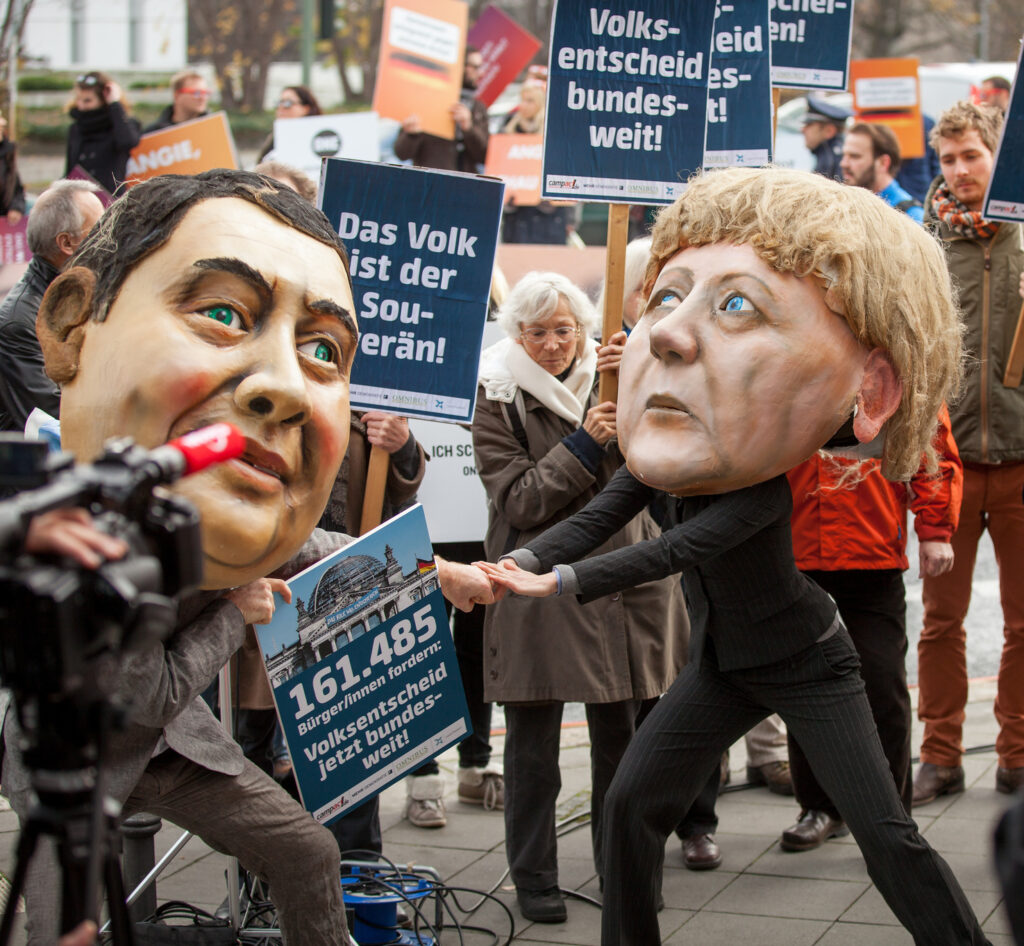Imagine that instead of Angela Merkel leading Germany since 2005, a vibrant leftist coalition of Social Democrats, Greens, and Democratic Socialists had governed Europe’s most powerful state. Today’s Europe might not—who knows?—find itself in such straights with the EU in shambles, the Eurozone crisis pitting North against South, and economic inequality in Germany starker than ever. Certainly, a leftist alliance would have found a way around the austerity policies that have impoverished Greece and checked recovery across southern Europe. It is mind-bending to think away a pillar such as Angela Merkel: in hindsight her twelve years in office—plus, almost certainly, another term come election day on September 24—look etched in stone, and indeed she will leave an indelible mark on Germany and Europe.
What is preventing a left-wing alliance that could supply Podemos and Syriza and Labour with a natural ally, and shake up the old continent?
But a leftist alternative was a realistic possibility in Germany—and remains so. In fact, in the 2005 national vote, the three leftist parties—the Social Democrats (SPD), the Greens, and Die Linke—actually tallied up majorities which, at least in terms of electoral arithmetic, could have ushered in a “red-red-green” government. Regionally, all-left coalitions currently govern in Berlin and Thuringia. In the 2009 vote, the left’s combined numbers missed overtaking the conservatives only by a hair—as will probably be the case this year. Arguably, the left could have made up the tiny difference had the parties collaborated loosely with one another. But they did not—and still are not collaborating this time around. Indeed, German leftists’ foremost enemy is not Germany’s popular, equivocal chancellor, but rather themselves.
• • •
Social Democrats
The backbone to any collaborative left-wing project in Germany is the storied Sozialdemokratischen Partei Deutschlands (SPD). Yet, the 150-year-old SPD has lost its way, so much so that it believes its only avenue to power is a “grand coalition” with Merkel’s conservative Christian Democrats (CDU), a path the party chose in both the 2005 and 2013 elections. Indeed, long gone are the days when the SPD could win on its own, or even with the aid of the Greens, as it did in 1998 and 2002, which ushered in Germany’s first “red-green” administration. The SPD’s voter bloc has withered so dramatically since then that it now needs more than just the little environmental party. As with other social democratic parties in Europe, the SPD can no longer count on the traditional working class, which has dwindled in Germany’s post-industrial economy. This it cannot help, but it could finally shed its stuffy, all-male, union-hall aura, as it must do in order to reach new voters, women, and the broader middle classes.
Moreover, the party fueled its own demise in the aughts by authoring free-market reforms that pared back the welfare state and sank taxes for the well-off. SPD chancellor Gerhard Schröder, facing record unemployment, instituted “New Economy” reforms that flew in the face of SPD orthodoxy, and it cost red-green the vote in 2005. The party has been hemorrhaging comrades ever since (the SPD actually refers to its members as GenossInnen, or comrades, one sign of its inability to adjust to the Zeitgeist). Adding to this, its tenure in the grand coalition has prevented the SPD from rejuvenating, forced as it is to compromise with Merkel’s CDU on almost everything. In fact, the CDU has compromised plenty, too, on a wide range of initiatives that bear the SPD’s signature, including a minimum wage, a new integration law, gay marriage, ending conscription, expanding citizenship, and tougher rent controls. The SPD’s conundrum is that Merkel gleans much of the credit for these progressive changes, overshadowing the coalition’s de facto font of ideas and policy.
A red-red-green coalition would require major concessions from all three parties, but a deal between them could unseat Merkel.
Then appeared Martin Schulz, the SPD’s ostensible savior. Schulz, a 61-year-old Rhinelander, stepped back from the European Parliament late last year to lend his beleaguered party a hand, it having slipped to under 20 percent in the polls, a historic low. Even before he was named the party’s candidate, he hit the campaign trial running, and a most incredible phenomenon unfolded. Schulz, a gregarious, former small-town mayor, openly took issue with the Schröder-era reforms by addressing the widening gap between rich and poor in Germany’s social welfare state. He spoke about harried, middle-class parents, about underpaid workers in the precarious service sector, about Germany’s crumbling infrastructure. His popularity soared. By March, the SPD had crawled out of its cellar and pulled even with the CDU. Schulz polled higher than Merkel for two months. The SPD was euphoric.
But all that glitters is not gold. The Schulz comet faded when he failed to produce workable policies to match the bombast. “He was way overrated,” explains Petra Pinzler of the weekly Die Zeit. “Voters were obviously looking for someone to replace Merkel, someone internationally known and with charisma. But in the end Schulz just wasn’t that good.”
Schulz is a middle-of-the-road social democrat, not a populist firebrand. Pinzler points out that Schulz simply is not the type of SPD politico to lead the party into a leftist coalition, which is the only way the SPD can wrench itself free of Merkel. Schulz has no track record whatsoever with leftist coalitions. In fact, in Brussels he “was all about grand coalitions [with conservative parties]. He fought Greens and socialists,” says Pinzler. When the SPD was roughed up badly in a regional vote in the Saarland in March, where it had banked on a red-red or red-red-green coalition, Schulz beat a hasty retreat. Just as it had done in Saarland, he surmised, the right could dangle the boogeyman of radical socialism in the face of German voters across the country, scaring them away from the SPD. But drifting back to the center solved nothing. Schulz’s flight from leftist topics and partners has put the SPD at about 22 percent, 4 points lower than 4 years ago, and with nothing but another grand coalition (or a term in opposition) in sight.
The Greens
The little environmental party, born of seventies’ social movements and now comfortably settled in the mainstream, would be the linchpin in any red-red-green alliance. Decades ago, the party that had once seen itself as a disruptive “anti-party party” accepted that meeting the SPD (at least) halfway was its only route to power—and, to its benefit, the Federal Republic now reflects much of its liberal, ecological premises. The renewable energy boom, nuclear power phase-out, and equality for LGBT Germans, among other milestones, are all products of the Greens and their cultural revolution.
One could indeed say that the Greens are now victim of their own success, struggling as they do to distinguish themselves from the other parties, all of which have taken pages from the Green playbook. Nevertheless, climate protection is nowhere near the top of the other parties’ programs. By contrast, environmental sustainability figures in each of the first three points of the Greens’ ten-point election manifesto. The Greens claim that Germany’s power supply can be 100-percent renewable by 2030. And they say they will not partner with any party unwilling to prioritize shuttering Germany’s twenty dirtiest coal-fired power plants as swiftly as possible. But the urgency of such proposals seems to resonate with only about 8 percent of voters.
Why is climate change not a red-button campaign issue in Germany, I asked the prominent Green Reinhard Bütikofer, especially in light of the forest fires that devastated southern Europe all summer long? “Many Germans think that the Energiewende (Germany’s renewable energy transition) and the Paris agreement (the UN climate accord, signed in 2015) are under way, that Germany is already doing the right thing and that thus the problem is under control. That is uninformed or naïve or lying to themselves. Whatever, it is not mobilizing them to vote Green.”
The Left Party
Die Linke is the dark horse in the picture. The Democratic Socialists, which evolved out of the successor to East German communist party, West German Marxists, and SPD defectors, has its bastion in the eastern states, but increasingly also represents an assortment of antiestablishment denizens across Germany. Contrary to expectations, it has survived a quarter of a century since the wall fell. Young Germans, in particular, have been inspired by its hardnosed critique of neoliberalism. On paper, its rhetoric can sound quite radical: no caps on immigration, no German troops abroad, no NATO, a sweeping redistribution of wealth from top to bottom, and abolition of (any) private health care. But when in power—in regional alliances with the SPD or Greens—the party conducts itself sensibly, open to the compromises required of governance.
• • •
So then, what is preventing a three-way alliance that could supply Podemos and Syriza and Labour with a natural ally, and shake up the old continent?
The German left's foremost enemy is not Germany’s popular, equivocal chancellor, but rather themselves.
The primary impediment is bad blood between the SPD and Die Linke. The Social Democrats have not forgiven their defectors, such as former party chief Oskar Lafontaine, who, disillusioned with the Schröder-era reforms, fled for Die Linke. Without them, says today’s SPD, Die Linke would have shriveled into an inconsequential, regional, eastern party. Moreover, the SPD understandably says it could not govern with a party that refuses to approve funding for German peacekeeping missions abroad.
Indeed, the red-red-green option would require major concessions from all three, including Die Linke turning the other cheek to humanitarian interventions abroad. The SPD would have to cut its umbilical cord to the coal industry. Nevertheless, the threesome could strike a deal and perhaps unseat Merkel, a prospect surely worth the flexibility.
This, though, would mean running with red-red-green as the desired goal, rather than as a possible option if the electoral arithmetic happened to add up. The SPD above all would have to act as if it desired an all-left outcome—and was convinced it would work. The SPD, and now the Greens too, shy away from positions that could estrange them from the CDU (the Greens have an eye on replacing the SPD in a coalition with Merkel). Such a left alliance would not mean coordinating their election campaigns as one team, but rather a loose alliance. Each party would have to showcase one policy that the other two parties would endorse but which the CDU would never endorse—for example, exiting coal by 2020 (Greens), banning arms exports to the Middle East (Left Party), and a progressive inheritance tax or basic income (SPD).
This, suddenly, would present Germans with a real choice, and a hard-fought election campaign worthy of the name. Instead, they are getting a race with the intensity of a badminton game, and the inevitable result of four more years of Merkel.





